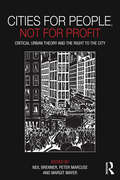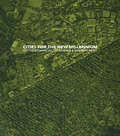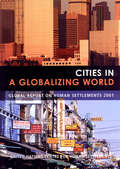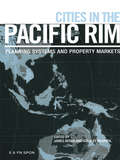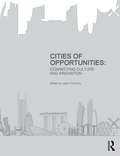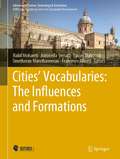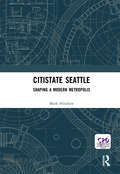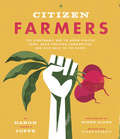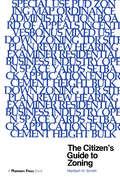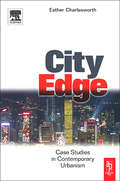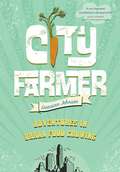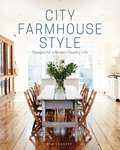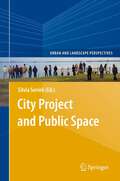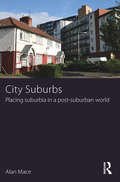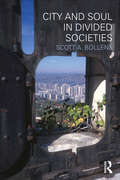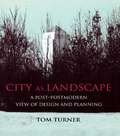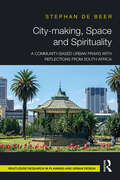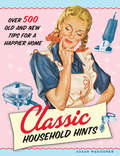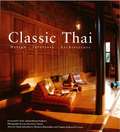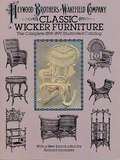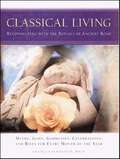- Table View
- List View
Cities for People, Not for Profit: Critical Urban Theory and the Right to the City
by Peter Marcuse Margit Mayer Neil BrennerThe worldwide financial crisis has sent shock-waves of accelerated economic restructuring, regulatory reorganization and sociopolitical conflict through cities around the world. It has also given new impetus to the struggles of urban social movements emphasizing the injustice, destructiveness and unsustainability of capitalist forms of urbanization. This book contributes analyses intended to be useful for efforts to roll back contemporary profit-based forms of urbanization, and to promote alternative, radically democratic and sustainable forms of urbanism. The contributors provide cutting-edge analyses of contemporary urban restructuring, including the issues of neoliberalization, gentrification, colonization, "creative" cities, architecture and political power, sub-prime mortgage foreclosures and the ongoing struggles of "right to the city" movements. At the same time, the book explores the diverse interpretive frameworks – critical and otherwise – that are currently being used in academic discourse, in political struggles, and in everyday life to decipher contemporary urban transformations and contestations. The slogan, "cities for people, not for profit," sets into stark relief what the contributors view as a central political question involved in efforts, at once theoretical and practical, to address the global urban crises of our time. Drawing upon European and North American scholarship in sociology, politics, geography, urban planning and urban design, the book provides useful insights and perspectives for citizens, activists and intellectuals interested in exploring alternatives to contemporary forms of capitalist urbanization.
Cities for the New Millennium
by Andrew Saint Marcial EcheniqueCities for the New Millennium is the outcome of a joint conference held in Salford in July 2000 by the Royal Institute of British Architects and the University of Cambridge's Department of Architecture. It tackles these questions in the light of the Urban Task Force's report about the future of Britain's cities and communities, but sets them in an international and historical context. Professionals - architects, engineers and developers as well as academics from different countries and disciplines here lavish their expertise on issues of transportation, density, land use, risk and energy saving; others present urban-scale buildings or landscapes that have been judged inspirational or inventive. This book, therefore, is not just about theories of urbanism. It reveals how co-operation and debate between different parties and professions can illuminate the creative kind of urban development we should be aiming for.
Cities in a Globalizing World: Global Report on Human Settlements
by Un-Habitat'The world has entered the urban millennium. Nearly half the world's people are now city dwellers, and the rapid increase in urban population is expected to continue, mainly in developing countries. This historic transition is being further propelled by the powerful forces of globalization. The central challenge for the international community is clear: to make both urbanization and globalization work for all people, instead of leaving billions behind or on the margins. Cities in a Globalizing World: Global Report on Human Settlements is a comprehensive review of conditions in the world's cities and the prospects for making them better, safer places to live in an age of globalization. I hope that it will provide all stakeholders - foremost among them the urban poor themselves - with reliable and timely information with which to set our policies right and get the machinery of urban life moving in a constructive direction.' From the Foreword by Kofi Annan, Secretary-General, United Nations. Cities in a Globalizing World presents a comprehensive review of the world's cities and analyses the positive and negative impacts on human settlements of the global trends towards social and economic integration and the rapid changes in information and communication technologies. In this Global Report, the United Nations Centre for Human Settlements (Habitat) draws on specially commissioned and contributed background papers from more than 80 leading international specialists. The report focuses on recent trends in human settlements and their implications for poverty, inequity and social polarization. It develops advance knowledge for urban planning and management policies in support and promotion of inclusive cities and good urban governance. This major and influential report is the most authoritative and up-to-date assessment of human settlements conditions and trends. Written in clear, non-technical language and supported by informative graphics, case studies and extensive statistical data, it should be an essential tool and reference for academics, researchers, planners, public authorities and civil society organizations around the world.
Cities in the Pacific Rim: Planning Systems And Property Markets
by James Berry Stanley McGrealThe cities of the Pacific Rim are in one of the most dynamic spheres of the global economy. In the twenty first century the focus of global affairs is destined to shift from the West to the East. These cities offer a wide range of different responses to the demands that rapid growth puts on planning and infrastructure : from the laxity that has lead to the urban sprawl of Bangkok to the regulation that is characteristic of Singapore. This book considers the interactive relationships between the operation of the planning system and the role and performance of property development and real estate markets in 14 Pacific Rim cities drawn from both the Eastern and Western perspective. The dynamic underlying these relationships considers the interplay between administrative structures, legislative controls and policy issues examining the role of actors and agencies in the property development and investment process.
Cities of Opportunities: Connecting Culture and Innovation
by Jason PomeroyCulture refers to not only the arts but also other manifestations of human intellectual achievement regarded collectively. It similarly refers to the customs, institutions, and achievements of a social group, a people, or a nation. Innovation refers to the action or process of change, alteration, or revolution; a new method of idea creation or product that may bring about change. It is easy to assume that innovation may be juxtaposed to the preservation of culture and time-tested rituals. Yet as human settlements grew; and as streets and squares evolved through the diverse exchanges of people trading, celebrating, rallying and socially interacting, it should come as little surprise that cities and its places would become, and continue to be, centres of culture and innovation that can be inextricably linked. Culture and Innovation in cities can potentially take on different complexions if viewed through the lens of academics and practitioners drawn from different geographies, disciplines, or fields of expertise when addressing particular urban challenges. It is through this complexity of views that this book seeks to provide a broad perspective on culture and innovation in the context of global cities today; and a rich cornucopia of insights from thought leaders within their respective fields to shape the cities of tomorrow.
Cities on Rails: The Redevelopment of Railway Stations and their Surroundings
by Luca Bertolini Tejo SpitThe development of railway stations and their surroundings is an emerging feature in current urban projects. Based on a series of the most inspiring contemporary European examples of station redevelopment, this book will help planners and urban designers understand the specific and complex nature of station locations. Based on their extensive research, the authors, pioneers of studies in the field in the last few years, harness and expand the body of knowledge and present guiding principles and conditions for successful implementation of such planning projects.
Cities’ Identity Through Architecture and Arts (Advances in Science, Technology & Innovation)
by Nabil Mohareb Nicola Cavalagli Sreetheran Maruthaveeran Alessio CardaciThis book presents works that book offer a novel interpretation of how today's urban problems can be tackled through the efficient use of resources and the modeling of solutions to best utilize the available features of cities. The second edition of this book compiles several research papers that present a detailed discussion of the formation and identification of cities and illustrate different case studies that deal with historical areas and buildings as part of preserving cities' vocabularies and self-identities. By unfolding a stimulating variety of topics in relation to the conservation of culture and identity, the book provides insights into planners and decision-makers, aiding them in their contributions to the implementation of the 2030 Sustainable Development goals with reference to heritage preservation.
Cities’ Vocabularies: The Influences and Formations (Advances in Science, Technology & Innovation)
by Nabil Mohareb Antonella Versaci Yasser Mahgoub Sreetheran Maruthaveeran Francesco AlbertiThis book discusses several topics regarding different vocabularies, such as sacred architecture, heritage buildings, open spaces, landmarks, and street escapes, all of which have a direct influence on the city form. The city form is also affected by the indirect impact of the citizens themselves, for example their culture, which in turn depends on the arts, as can be seen and embodied in morals, paintings, media, digital art, and sculpture. The book also examines the fundamental elements that are responsible for the identity of the city. Presenting case studies that demonstrate the how implementing the concept of the responsibility of architecture and arts affects the development of our cities, the book offers a new approach that is based on the available features of a city and explores how planners and decision-makers can use these features to address the myriad problems that our cities are facing.
Citistate Seattle: Shaping A Modern Metropolis
by Mark HinshawWith style and humor, the author writes of special places in everyday Seattle. The author takes us to popular, high-profile landmarks like Pike Place Market as well as tucked-away gems — cozy cottages, trendy pubs, gracious apartment buildings, and vibrant urban villages — that flavor and enliven the city. The author shares his eye for unique, humanizing details of design, architecture, and function, bringing this colorful metropolis to life so vividly you'll practically smell the coffee they brew and sell on (almost) every street corner. Along the way, the author explains the public and private decisions that helped Seattle avoid the urban desolation that plagues other American cities. The author introduces many of Seattle's movers and shakers — mayors, developers, artists, and urban pioneers — who took it upon themselves to guide metropolitan Seattle along a different path.
Citizen Farmers: The Biodynamic Way to Grow Healthy Food, Build Thriving Communities, and Give Back to the Earth
by Susan Puckett Daron JoffeA guide to organic vegetable gardens and small-scale farming with an emphasis on sustainability. Biodynamic farming, with its focus on ecological sustainability, has emerged as the gold standard in the organic gardening movement. Daron Joffe—known as Farmer D—has made it his mission to empower, educate, and inspire people to become conscientious consumers, citizens, and stewards of the land. In this engaging call to action, Farmer D teaches us to not only create sustainable gardens but also to develop a more holistic, community-minded approach to how our food is grown and how we live our lives in balance with nature. Illustrated with photographs of gardens designed by Farmer D as well as line drawings, the book is packed with advice on: Establishing a biodynamic gardenCompostingSoil composition and replenishmentControlling pests and diseaseCooperative gardening practicesCreating delicious meals with your home-grown produce In collaboration with a James Beard Award–nominated food journalist, Farmer D offers an indispensable resource for anyone who wants to make the world a greener place.
Citizen's Guide to Zoning
by Herbert SmithFirst published in 1983. Routledge is an imprint of Taylor & Francis, an informa company. An easy-to-read book about zoning that cuts the jargon out but leaves the wisdom in. Smith explains the fundamental principles of zoning, how to develop zoning regulations, and the nuts and bolts of a zoning ordinance. He examines variances, zoning hearings, and frequent zoning problems.
City Building on the Eastern Frontier: Sorting the New Nineteenth-Century City (Creating the North American Landscape)
by Diane ShawAmerica's westward expansion involved more than pushing the frontier across the Mississippi toward the Pacific; it also consisted of urbanizing undeveloped regions of the colonial states. In 1810, New York's future governor DeWitt Clinton marveled that the "rage for erecting villages is a perfect mania." The development of Rochester and Syracuse illuminates the national experience of internal economic and cultural colonization during the first half of the nineteenth century. Architectural historian Diane Shaw examines the ways in which these new cities were shaped by a variety of constituents—founders, merchants, politicians, and settlers—as opportunities to extend the commercial and social benefits of the market economy and a merchant culture to America's interior. At the same time, she analyzes how these priorities resulted in a new approach to urban planning.According to Shaw, city founders and residents deliberately arranged urban space into three segmented districts—commercial, industrial, and civic—to promote a self-fulfilling vision of a profitable and urbane city. Shaw uncovers a distinctly new model of urbanization that challenges previous paradigms of the physical and social construction of nineteenth-century cities. Within two generations, the new cities of Rochester and Syracuse were sorted at multiple scales, including not only the functional definition of districts, but also the refinement of building types and styles, the stratification of building interiors by floor, and even the coding of public space by class, gender, and race. Shaw's groundbreaking model of early nineteenth-century urban design and spatial culture is a major contribution to the interdisciplinary study of the American city.
City Edge
by Esther CharlesworthThis series of essays outlines a number of case studies from Europe, North America, Australia and Asia and provides first hand accounts of the experiences that planners, architects and politicians have had in reshaping cities. These insights provide a pragmatic assessment of the challenges and constraints posed by changing patterns of urban growth in a broad spectrum of urban environments. The reader will discover, through these multiple voices and views, the diverse forms of global cities, and will have a grasp of where the debate on urban design stands today, and where it may be going in the future.
City Farmer
by Lorraine JohnsonCity Farmer celebrates the new ways that urban dwellers across North America are reimagining cities as places of food production. From homeowners planting their front yards with vegetables to guerilla gardeners scattering seeds in neglected urban corners, gardening guru Lorraine Johnson chronicles the increasing popularity of innovative urban food growing.
City Farmhouse Style: Designs for a Modern Country Life
by Kim Leggett&“With Leggett&’s guidance, these visits into farmhouse decorated homes provide the do-it-yourselfer with ideas for decorating their own abodes.&” —Library Journal Come along on the hunt to coveted country sources and the best secret antiquing spots, and learn how to create country farmhouse style in your city dwelling. Author Kim Leggett is the creator of City Farmhouse, an interior design business, pop-up antiquing fairs, and vintage store. She is also a legendary &“picker&” and favorite designer to celebrity clients (and country-style mavens) including Meg Ryan, Ralph Lauren, Sheryl Crow, and Phillip Sweet and Kimberly Schlapman of Little Big Town. In City Farmhouse Style, Leggett offers great style advice, breaking down the design vocabulary that makes for fresh country style (no matter the setting). The popularity of farmhouse style has designers, homeowners, and fans in search of inspiration to create this look in all its rural glory. City Farmhouse Style is the first design book of its kind to focus entirely on transforming urban interiors with unfussy, welcoming, country-style decor. &“With Kim&’s tips and style inspiration anyone can bring country to the city with ease.&” —Sheryl Crow, Grammy Award-winning singer-songwriter &“So, what happens when homeowners throw out the design rule book? Genius decorating ideas pop up everywhere. A flip through Leggett&’s book reveals dozens.&” —Architectural Digest &“Leggett celebrates the ageless appeal of farmhouse staples—and explains why the look isn&’t going anywhere. (You can bet the farm on it).&” —Country Living &“Forget your old definition of farmhouse style and learn about the diversity of the look.&” —American Farmhouse Style
City Project and Public Space (Urban and Landscape Perspectives #14)
by Silvia SerreliThe book aims at nurturing theoretic reflection on the city and the territory and working out and applying methods and techniques for improving our physical and social landscapes. The main issue is developed around the projectual dimension, with the objective of visualising both the city and the territory from a particular viewpoint, which singles out the territorial dimension as the city's space of communication and negotiation. Issues that characterise the dynamics of city development will be faced, such as the new, fresh relations between urban societies and physical space, the right to the city, urban equity, the project for the physical city as a means to reveal civitas, signs of new social cohesiveness, the sense of contemporary public space and the sustainability of urban development. Authors have been invited to explore topics that feature a pluralism of disciplinary contributions studying formal and informal practices on the project for the city and seeking conceptual and operative categories capable of understanding and facing the problems inherent in the profound transformations of contemporary urban landscapes.
City Suburbs: Placing suburbia in a post-suburban world
by Alan MaceThe majority of the world’s population is now urban, and for most this will mean a life lived in the suburbs. City Suburbs considers contemporary Anglo-American suburbia, drawing on research in outer London it looks at life on the edge of a world city from the perspective of residents. Interpreted through Bourdieu’s theory of practice it argues that the contemporary suburban life is one where place and participation are, in combination, strong determinants of the suburban experience. From this perspective suburbia is better seen as a process, an on-going practice of the suburban which is influenced but not determined by the history of suburban development. How residents engage with the city and the legacy of particular places combine powerfully to produce very different experiences across outer London. In some cases suburban residents are able to combine the benefits of the city and their residential location to their advantage but in marginal middle-class areas the relationship with the city is more circumspect as the city represents more threat than opportunity. The importance of this relational experience with the city informs a call to integrate more fully the suburbs into studies of the city.
City and Soul in Divided Societies (Planning, History and Environment Series)
by Scott A. BollensIn this unique book Scott A. Bollens combines personal narrative with academic analysis in telling the story of inflammatory nationalistic and ethnic conflict in nine cities – Jerusalem, Beirut, Belfast, Johannesburg, Nicosia, Sarajevo, Mostar, Bilbao, and Barcelona. Reporting on seventeen years of research and over 240 interviews with political leaders, planners, architects, community representatives, and academics, he blends personal reflections, reportage from a wealth of original interviews, and the presentation of hard data in a multidimensional and interdisciplinary exploration of these urban environments of damage, trauma, healing, and repair. City and Soul in Divided Societies reveals what it is like living and working in these cities, going inside the head of the researcher. This approach extends the reader’s understanding of these places and connects more intimately with the lived urban experience. Bollens observes that a city disabled by nationalistic strife looks like a callous landscape of securitized space, divisions and wounds, frozen in time and in place. Yet, the soul in these cities perseveres. Written for general readers and academic specialists alike, City and Soul in Divided Societies integrates facts, opinions, photographs, and observations in original ways in order to illuminate the substantial challenges of living in, and governing, polarized and unsettled cities.
City as Landscape: A Post Post-Modern View of Design and Planning
by Tom TurnerIn twenty essays, this book covers aspects of planning, architecture, urban design, landscape architecture, park and garden design. Their approach, described as post-postmodern, is a challenge to the 'anything goes' eclecticism of the merely postmodern.
City-making, Space and Spirituality: A Community-Based Urban Praxis with Reflections from South Africa
by Stéphan de BeerThis book is about the soul of the city, embodied in its spaces and people. It traces dynamics in inner city neighbourhoods of South Africa’s post-apartheid capital, Pretoria. Viewing the city through its most vulnerable people and places, it recognizes that urban space is never neutral and shaped by competing value frameworks. The first part of the book invites planners, city-makers, and ordinary urban citizens, to consider a new self-understanding, reclaiming their agency in the city-making process. Through the metaphor of "becoming like children", planning practice is deconstructed and re-imagined. A praxis-based methodology is presented, cultivating four distinct moments of entering, reading, imagining and co-constructing the city. After deconstructing urban spaces and discourses, the second part of the book explores a concrete spirituality and ethic of urban space. It argues for a shift from planning as technocracy, to planning as immersed, participatory artistry: opening up to the "genius" of space, responsive to urban cries, and joining to construct new, soul-full spaces. Local communities and interconnected movements become embodiments of urban alternatives – through resistance and reconstruction; building on local assets; animating local reclamations; and weaving nets of hope that will span the entire city. Providing a concrete methodology for city-making that is rooted in a community-based urban praxis, this book will be of interest to urban planning researchers, professional planners and designers and also grass-root community developers or activists.
Classic Household Hints: Over 500 Old and New Tips for a Happier Home
by Susan WaggonerAn illustrated, nostalgic how-to guide to achieving a clean, organized, and happy home—with over 500 retro tips and tricks! Return your household to the simpler times of yesteryear with this delightful guide full of time- and money-saving tips on everything from cleaning and organizing your home to buying and handling food. Even in an age of endless new household products and devices, these old-fashioned, tried-and-true methods can help any homeowner keep a cleaner, happier home. A thoroughly researched compendium of the best American home life tips from the 1920s through the &’60s, Classic Household Hints is filled with useful information, full-color illustrations, fascinating sidebars, and quotes—providing practical help as well as fun for housekeepers and neat freaks everywhere.
Classic Readings in Urban Planning: An Introduction
by Jay SteinThis new edition of "the best anthology in planning" includes 33 selections by many of the profession's most respected thinkers and eloquent writers. Returning editor Jay M. Stein chose the articles, about half of them new to this edition, based on suggestions from colleagues and students who used the first edition, recommendations from planning scholars, awards for writing in the field of planning, and his own review of recent planning literature. Classic Readings in Urban Planning offers an unparalleled depth of coverage and range of perspectives on traditional aspects of planning as well as on important contemporary issues. This is an exceptional main or supplementary textbook for advanced undergraduate or beginning graduate level students in urban and regional planning. As a general overview of the field of urban planning, it is also an excellent choice for planning commissioners, practicing planners, and professionals in related fields such as environmental and land use law, architecture, and government. An abstract introduces each reading, and each section includes suggestions for additional readings suitable for more extensive study. Many of these are also "classics" that could not be included as a main selection.
Classic Thai
by Luca Invernizzi Tettoni Chami Jotisalikorn Virginia Di Crocco Phuthorn BhumadhonFrom the glittering chedis of Bangkok's Grand Palace to the rustic simplicity of village dwellings, Thailand offers a rich diversity of art, architecture and design. Classic Thai seeks to define the unique characteristics of Thai style, be it through the country's rich arts and crafts tradition, in its plentiful temples and palaces, or in a contemporary home. Photographed entirely on location, Classic Thai is an indispensable guide to the wonders of Thailand.
Classic Wicker Furniture
by Heywood BrothersComplete reproduction of rare 1897 premiere issue of most famous wicker company catalog; probably finest primary source. Includes rocking chairs, armchairs, divans, tables, cabinets, etc. Over 400 illustrations. Indispensable reference for antique dealers, collectors, Americana buffs.
Classical Living: Reconnecting with the Rituals of Ancient Rome
by Frances BernsteinEnhance your life using the riches of the Roman tradition. An authority on ancient Roman culture, Frances Bernstein shows you how to draw on the wisdom, history, myths and ancient prayers that were a part of everyday Roman life to achieve abundance and serenity in your own. This beautiful volume combines delectable recipes such as fava bean salad for good digestion and a healthy body with rituals such as water healing in a luxurious bath to nurture oneself and to honor the deities who rule each month. As the author illustrates, "Sexuality, fertility, nature, and spirituality were so closely interwoven in antiquity that it was difficult for the ancient pagan to imagine them apart."From autumn's introspective thresholds and winter's purification rituals to the warm fullness of spring and the bittersweet heat of summer, Bernstein shares stories of ancient Roman practices and festivals and offers modern rituals to help you create meaningful, new traditions of your own. In January, give gifts of warm honey cake to banish darkness, instill good will, and bring about harmonious relationships. Honor Bacchus, the god of March, and Liberalia with a rustic wine tasting, and celebrate Venus, the goddess of April, with a sensuous bath brimming with floating rose petals. Remember the fate of Adonis in July with celebrations of renewal, or design a sacred landscape in your garden with fountains, bells, altars, and blossoming flowers to please the goddess Flora.With poetry, wisdom, and historical insight, Frances Bernstein offers Roman traditions and rituals for modern spiritual practice, making Classical Living an inviting source to treasure throughout the year.
